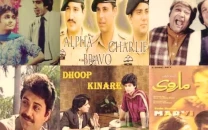The confluence of comics and music
Zohaib Kazi’s ‘Ismail Ka Urdu Sheher’ is a concept album and graphic novel set in post-apocalyptic times

Once the album is released, Kazi plans on releasing music videos for a selected few tracks. PHOTOS: PUBLICITY
Ismail Ka Urdu Sheher has seen many phases of conceptual actualisation. What started off as a feature film back in 2006 took shape of a concept album and has been so for the past nine years. Music producer Zohaib Kazi’s brainchild only saw one more change – a graphic novel accentuating the album’s overarching theme.
A general lack of resources and market demand forced Kazi to quit the idea of scripting the film. “No one thought of making a film [of this kind] back then. So I said to myself that an easier way would be to turn it [the concept] into an illustrated book or a graphic novel,” he told The Express Tribune. Now that the project is nearing completion and is expected to see the light of day soon, Kazi feels the dual nature of the album might help it resonate with the audiences.
In the recent past, many Pakistani artists have attempted to dabble with the prospects of releasing comics but none of them have been successful in kick-starting their market. “Since it is intertwined with music, something that everyone listens to, and also a video, I think it may pave the way for a [comic-book reading] culture,” said Kazi.
Noori breaks open the ‘Pinjra’
The first-of-its-kind album and graphic novel are set against the backdrop of a post-apocalyptic, dystopian world marred by a dearth of energy sources. While attempting to solve the energy crisis, two scientists stumble upon information that could change the history of the planet. Putting blood and sweat into the idea, they manage to put together a machine called the Large Zodron Collider to create energy. Their actions end up recreating the world and even a far-off planet, Elaan, is not able to save itself from its effects. It all boils down to another scientist, Ismail, to fend the catastrophe off.

Although the project has been on Kazi’s desk for years, his visit to the Dubai Comic Con helped him put things into perspective. The driving force behind the album is the desire to promote local pop culture and folklore. “I saw that the Middle-Eastern people had their own ideas and they were incorporating them into comic books, so that gave me the confidence to pursue the project,” he remarked.
Conceptualisation wasn’t the only area that Kazi put effort into. He elaborated on how he had to go through the arduous task of pitching the record to various labels and music channels that came and went in the past decade. All of them had one recommendation for Kazi: change the sound to something more contemporary pop and semi-classical.
Two birds out of a gilded cage
Unwilling to surrender his own ideas to these corporations, he continued with his own approach, focusing on keeping the sound electronic. “The music is very South Asian and Pakistani electronica and I chose this style as I wanted to create a soundscape that would reflect a futuristic South Asia and Pakistan in specific.” This gives rise to the question of whether or not the electronic sound has been utilised to complement the concept’s temporal setting. Kazi is quick to respond to this. “This is not the case since all the tracks on the album do not follow the same style. Kinaara and Black Coffee are different.”
Expected to be out sometime in December, the 12-track album and the graphic novel feature artists such as Zoe Viccaji, Sara Haider, Omran ‘Momo’ Shafique, Abbas Ali Khan and Jaffer Zaidi. Once the album is released, Kazi plans on releasing music videos for a selected few tracks.
Published in The Express Tribune, November 13th, 2015.
Like Life & Style on Facebook, follow @ETLifeandStyle on Twitter for the latest in fashion, gossip and entertainment.



















COMMENTS
Comments are moderated and generally will be posted if they are on-topic and not abusive.
For more information, please see our Comments FAQ